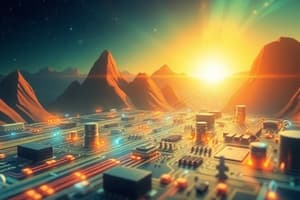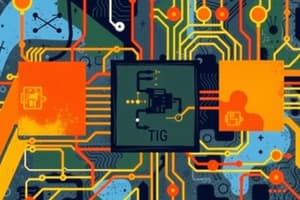Podcast
Questions and Answers
What is the primary role of a sensor in electronic systems?
What is the primary role of a sensor in electronic systems?
- To provide power supply
- To convert physical phenomena into electrical signals (correct)
- To store electrical energy
- To amplify signals
Which statement best describes the function of a DAC?
Which statement best describes the function of a DAC?
- It amplifies analog signals to digital form.
- It transforms digital data into continuous analog signals. (correct)
- It stores analog signals in digital format.
- It converts digital signals into magnetic fields.
What distinguishes open-loop systems from closed-loop systems?
What distinguishes open-loop systems from closed-loop systems?
- Open-loop systems operate without feedback. (correct)
- Open-loop systems use feedback to control output.
- Closed-loop systems do not require any input.
- Closed-loop systems are less efficient than open-loop systems.
What is the role of an inductor in an electronic circuit?
What is the role of an inductor in an electronic circuit?
Which of the following defines what a logic gate does?
Which of the following defines what a logic gate does?
What is the main purpose of an RC circuit?
What is the main purpose of an RC circuit?
Which of the following best describes insulators in electronic systems?
Which of the following best describes insulators in electronic systems?
What role do logic gates play in electronic systems?
What role do logic gates play in electronic systems?
Which statement accurately describes the function of a transistor amplifier circuit?
Which statement accurately describes the function of a transistor amplifier circuit?
What is the distinction between open-loop and closed-loop systems?
What is the distinction between open-loop and closed-loop systems?
Flashcards are hidden until you start studying
Study Notes
Analogue vs Digital Signals
- Analogue signals are continuous waves that vary over time, representing information with a range of values.
- Digital signals are discrete waves that use binary values (0s and 1s) to represent information in distinct steps.
Sensor
- A sensor is a device that detects physical properties (e.g., temperature, light, pressure) and converts them into signals that can be read by an observer or instrument.
- Common types of sensors include temperature sensors (thermometers), light sensors (photocells), and motion sensors (PIR).
RC Circuit
- An RC circuit consists of a resistor (R) and a capacitor (C) and is used for filtering, timing applications, and signal processing.
- It can act as a low-pass or high-pass filter, allowing certain frequencies to pass while attenuating others.
Insulators
- Insulators are materials that impede the flow of electric current, preventing unintended conductivity.
- Common insulators include rubber, glass, and plastics, which are widely used in electrical wiring and equipment.
Function of a DAC
- A Digital-to-Analog Converter (DAC) transforms digital signals (binary) into analogue voltage levels.
- This device is crucial for applications such as audio playback, where sound waves must be reproduced from digital data.
Transistor Amplifier Circuit
- A transistor amplifier circuit uses transistors to increase the amplitude (power) of a signal.
- It is foundational in audio and radio frequency applications, allowing weak signals to be amplified for further processing.
Logic Gate
- Logic gates are fundamental building blocks in digital circuits that perform logical operations on one or more binary inputs to produce a single output.
- Common types include AND, OR, NOT, NAND, and NOR gates, each processing signals according to specific rules.
Electronic System
- An electronic system consists of interconnected components that work together to perform specific tasks using electrical energy.
- Examples include computers, smartphones, and communication devices, each serving various functions through complex interactions.
Open-Loop vs Closed-Loop Systems
- Open-loop systems operate without feedback, meaning output is not influenced by the system's performance or changes, e.g., a simple timer.
- Closed-loop systems use feedback mechanisms to adjust and control output based on actual performance relative to a desired state, e.g., a thermostat regulating temperature.
Function of an Inductor
- An inductor stores energy in a magnetic field when an electric current passes through it and can oppose changes in current flow.
- It is primarily used in filtering applications, energy storage, and in inductive coupling for transformers.
Analogue vs Digital Signals
- Analogue signals are continuous waves that vary over time, representing information with a range of values.
- Digital signals are discrete waves that use binary values (0s and 1s) to represent information in distinct steps.
Sensor
- A sensor is a device that detects physical properties (e.g., temperature, light, pressure) and converts them into signals that can be read by an observer or instrument.
- Common types of sensors include temperature sensors (thermometers), light sensors (photocells), and motion sensors (PIR).
RC Circuit
- An RC circuit consists of a resistor (R) and a capacitor (C) and is used for filtering, timing applications, and signal processing.
- It can act as a low-pass or high-pass filter, allowing certain frequencies to pass while attenuating others.
Insulators
- Insulators are materials that impede the flow of electric current, preventing unintended conductivity.
- Common insulators include rubber, glass, and plastics, which are widely used in electrical wiring and equipment.
Function of a DAC
- A Digital-to-Analog Converter (DAC) transforms digital signals (binary) into analogue voltage levels.
- This device is crucial for applications such as audio playback, where sound waves must be reproduced from digital data.
Transistor Amplifier Circuit
- A transistor amplifier circuit uses transistors to increase the amplitude (power) of a signal.
- It is foundational in audio and radio frequency applications, allowing weak signals to be amplified for further processing.
Logic Gate
- Logic gates are fundamental building blocks in digital circuits that perform logical operations on one or more binary inputs to produce a single output.
- Common types include AND, OR, NOT, NAND, and NOR gates, each processing signals according to specific rules.
Electronic System
- An electronic system consists of interconnected components that work together to perform specific tasks using electrical energy.
- Examples include computers, smartphones, and communication devices, each serving various functions through complex interactions.
Open-Loop vs Closed-Loop Systems
- Open-loop systems operate without feedback, meaning output is not influenced by the system's performance or changes, e.g., a simple timer.
- Closed-loop systems use feedback mechanisms to adjust and control output based on actual performance relative to a desired state, e.g., a thermostat regulating temperature.
Function of an Inductor
- An inductor stores energy in a magnetic field when an electric current passes through it and can oppose changes in current flow.
- It is primarily used in filtering applications, energy storage, and in inductive coupling for transformers.
Studying That Suits You
Use AI to generate personalized quizzes and flashcards to suit your learning preferences.




